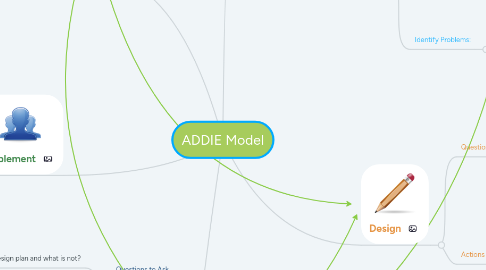
1. Develop
1.1. Questions to Ask
1.1.1. WHAT: What is going according to the design plan and what is not?
1.1.2. HOW: How are the design ideas taking form?
1.2. Actions to Take
1.2.1. Begin building! In this phase, the design plans are actualized and take form. Typically, for online learning this will involve and LMS platform, building the content around the navigation inherent to the LMS, or creating a new system of navigation.
1.2.2. Begin creating! In the design phase, we might have decided what content would be included and created for the course. Now that content actual gets written, recorded, or added. Decisions made in the design process become tangible.
1.2.3. Revisit the Design phase as needed. As the plans from the design phase are implemented in the development phase, new problems may be encountered that couldn't have been anticipated before.
1.2.4. Prototype. To solve problems identified in the analysis and design phases, create mock-ups of the solution(s) arrived at and see which will work best to resolve the problem. For example, if the technology learners need to use will have a learning curve, create a tutorial. Maybe a written tutorial will be preferable to a video tutorial, but prototypes of both can be developed to see which will work best. Sometimes we don't know until we prototype.
2. Implement
2.1. Questions to Ask
2.1.1. WHAT: What tools will learners need to begin implementation?
2.1.2. WHEN: When will implementation begin and conclude?
2.1.3. WHAT: What data is being gathered, both quantitative and qualitative, that will set up a successful evaluation process?
2.2. Actions to Take
2.2.1. Tools are provided to learners.
2.2.2. Delivery occurs..
2.2.3. Assessments are conducted.
2.2.4. The why, how, etc. from the previous phases are imparted to teachers and trainers.
3. Evaluate
3.1. Questions to Ask
3.1.1. HOW: How are the learning objectives being met? How are they not being met?
3.1.2. WHAT: What worked? What didn't work? What problems were encountered that were not anticipated?
3.1.3. WHEN: When can changes be made and new solutions implemented?
3.2. Actions to Take
3.2.1. Assess whether learning outcomes are being met, new problems have arisen, challenges learners are encountering. Identify areas for improvement.
3.2.2. Return to other phases of the process depending on what is found through evaluation. Return to the analysis phase if learners encounter unanticipated problems. Return to the design phase to create a new solution for a problem. Return to the Development phase to add new content.
4. Analyze
4.1. Questions to Ask
4.1.1. WHO: Who is the audience?
4.1.2. WHEN: What is the timeline?
4.1.3. WHERE: What is the method of delivery?
4.1.4. WHY: What result (learning outcomes) will be achieved?
4.2. Actions to Take
4.2.1. Identify Goals:
4.2.1.1. Start with Why: While the curriculum, method of delivery, and timeline are all important factors to consider, the "why" for learners is of paramount importance in this stage. Research from the University of Delaware and the University of Florida has shown that when we focus on why we want to do something, it's easier to achieve. During analysis, we should make the why for learners central to forming goals. Click the arrow for an article that explains how Simon Sinek's "start with why" principle applies to goal-setting for educators and learners.
4.2.2. Audience Analysis:
4.2.2.1. Learn about your learners, both demographically and situationally. For example, demographic analysis looks at age (adult learner?), education level (previous degrees or trainings?), etc.. Situational analysis looks at receptivity (is participation required?), location (remote or in person?), etc. Click the arrow for a comprehensive audience analysis list.
4.2.3. Identify Problems:
4.2.3.1. Now that we know who our audience is and the why that will motivate them to learn, we have the information we need to identify problems or obstacles. This is where the facts we've gathered interact. For example, maybe interaction is a goal and there may be a piece of technology that will enable learners to interact consistently, but we know from audience analysis that there will be a learning curve for them to use the technology.
5. Design
5.1. Questions to Ask
5.1.1. WHAT: What information will learners need to achieve their why? What will the lessons consist of? What assessments will be best at evaluating learning outcomes? What resources will learners need?
5.1.2. HOW: How will information be delivered (medium)? How will the information be structured (organization)?
5.1.3. WHEN: When will learners complete certain objectives, lessons, tasks, assessments, etc? How will the course be paced (asynchronous, synchronous)?
5.2. Actions to Take
5.2.1. Here is where the why (the outcome) begins to drive the how (the process for achieving the outcome). Decisions are made about how to achieve the goals outlined, in combination with what we know about our learners and their needs and expectations. We also design solutions for any problems we anticipate.
5.2.2. Storyboarding is a great tool for the design process because it helps to map out the how while continually connecting back to the why. We are able to consider sequencing more effectively because the connections between activities become clear, and when this happens, learners are more able to understand how each lesson, activity, or assessment links back not only to earlier aspects of the course or training, but also the larger learning outcome(s) they are working toward. Click the arrow for helpful Lynda tutorials on storyboarding.

